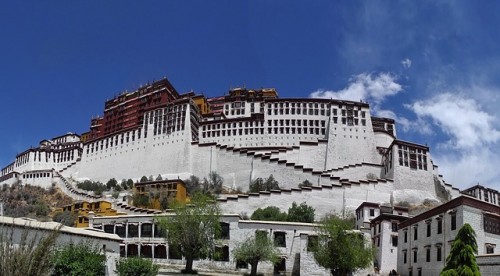Nestled in the capital of Tibet, the Potala Palace is the historical landmark as well as the greatest monument. The white-shimmering palace soars upon the Marpo Ri hill that is believed to be sacred because of a holy cave where Bodhisattva Chenresi (Avilokiteshvara – bodhisattva of compassion) used to dwell. Further, the name ‘Potala’ comes from Mt. Potala of south India, which is the legendary mountain dwelling of the Bodhisattva. Some 50 years ago, this edifice of 1648 functioned as the main residence of the Dalai Lama. However, after a failed uprising in 1959, the 14th Dalai Lama escaped to Dharamsala in India. Currently, the Potala Palace is now the site of a state museum, a UNESCO World Heritage Site, and one of the ‘New Seven Wonders of the World’ as per Good Morning America (show) and USA Today (newspaper).
What you see today is obviously not the original one built in the 7th century A.D. Since this period until today, the Potala Palace has played various roles besides being the home of the Lama and his huge staff. It was the venue of all stately ceremonies, seat of Tibetan government, a school for the monks’ religious training, and was also a major pilgrimage destination due to the past Dalai Lamas’ graves resting here.

Overlooking the entire Lhasa, the palace boasts a strong citadel-like looks. The structure is not only vertically high, but is also horizontally wide accommodating over thousand rooms identified by names as well as numbers and many stairways. At the base, the stone walls are thick; while in the upper storeys, they are comparatively thinly erected. In the front of the Potala Palace, a great plaza can be seen flanked by gates as well as walls at the rock’s south base.
To explore the palace, an array of easy staircases cut by the gentle ascents at intervals takes one up to the pinnacle of the rock. So, get ready to climb; but with breaks and rests to get used to the high altitude. The entire structure is composed of two major parts that are differentiated easily by color. They are called the White Palace and Red Palace and are connected by a small yellow edifice that stores the holy banners dangled on the exterior during the New Year celebrations.
White Palace
Also known as Potrang Karpo, this secular White Palace flanks the Red Palace. This was the actual former home of the Lama as well as his monks. Originally, it was not so vast, but the expansions over the years have made it so stretching. Besides the monastic living quarters, there exist many offices, a printing house, and the seminary for training the government officials.
There are also two small chapels here namely, the Chogyal Drubphuk and Phakpa Lhakhang (Saint’s Chapel) of the 17th century. In addition to being the most ancient surviving structures, they are also the holiest ones. In the latter, the most venerated statue of the palace, the Arya Lokeshvara, resides drawing thousands of Tibetan pilgrims daily. Below this chapel, look for the Dharma Cave that is believed to be the learning place of King Songtsen Gampo who was thought to be the incarnation of Bodhisattva. This is where he studied the Buddhist scriptures in the 7th century.
Red Palace
Also known as the Potrang Marpo, this forms the heart of the palace and is meant for religious purposes. It is very well adorned with carvings as well as jeweled work and holds a myriad of shrines along with the holy tombs of eight Dalai Lamas. Just in front of these tombs, valuable votive offerings can be seen including a pagoda that is composed of lakhs of pearls. The murals within this Palace reveal the life of fifth Dalai Lama whose mummified body is seen in a long stupa layered in gold as well as semi-precious stones. Spot for a chapel where he is enthroned just like the Buddha. There is also a glorious golden tomb-stupa dedicated to the last Lama who gave total independence to the nation.
Other attractions include assembly hall of monks; several shrines as well as chapels dedicated to Buddhas, bodhisattvas, demons, and saints; and libraries housing vital Tibetan Buddhist scriptures.
Timings
9 am to 3 pm every day.
Admission rules
Confined to 2,500 tourists daily with reservations made prior a day.
Entry fees
Ticket costs ¥100 and reveal the entry time; extra ¥10 for relics museum and roof.
